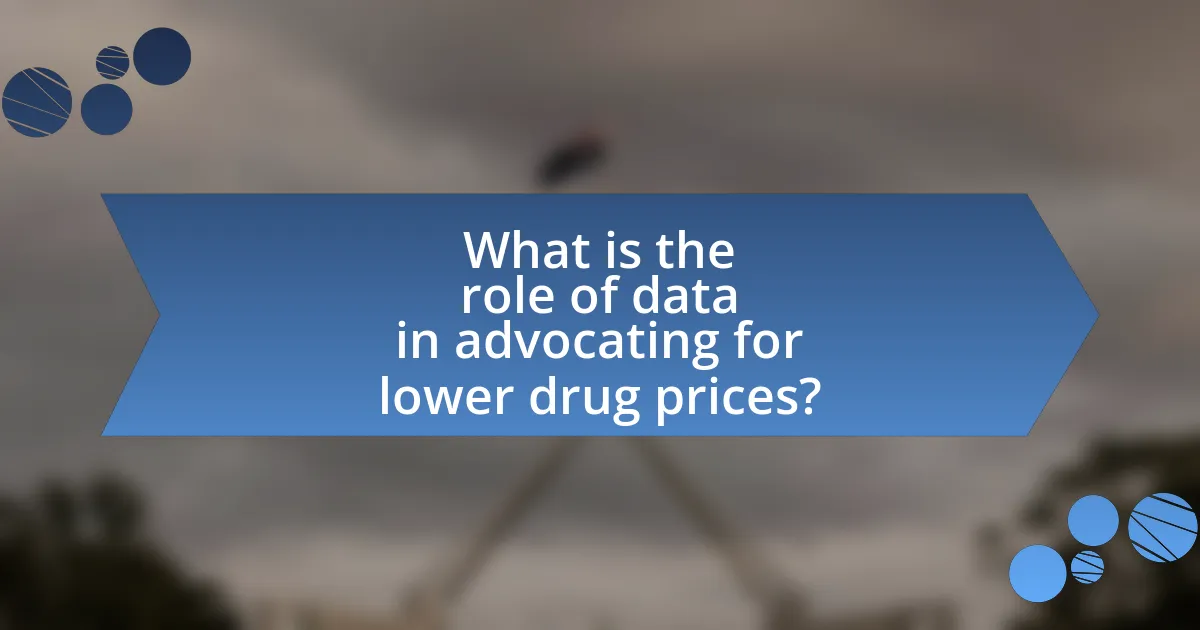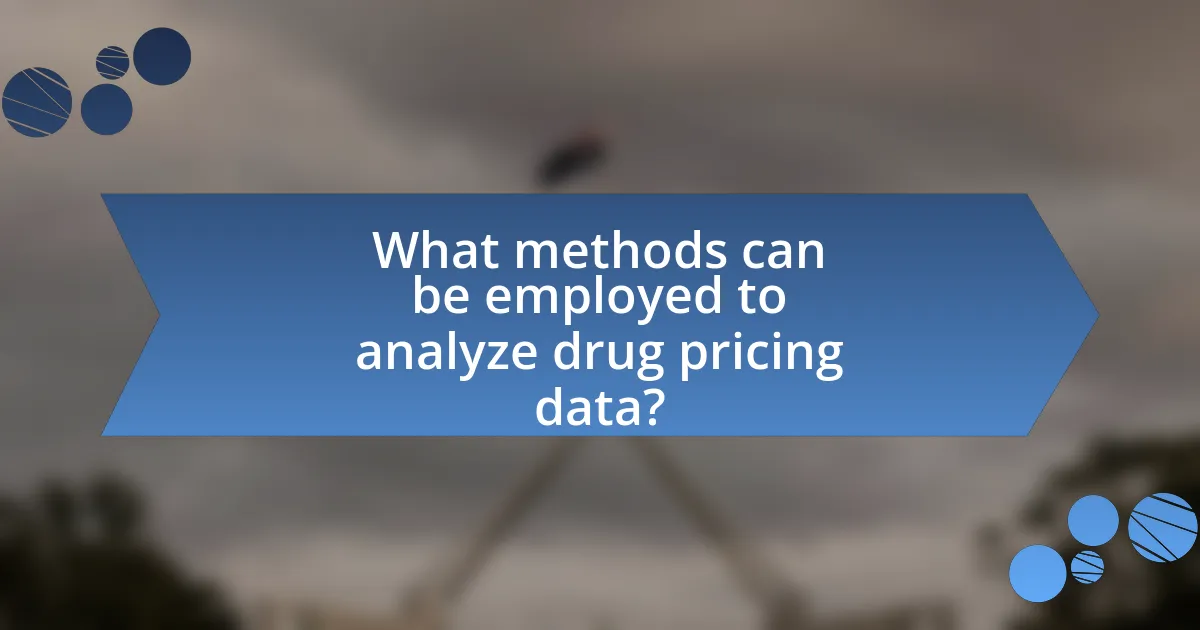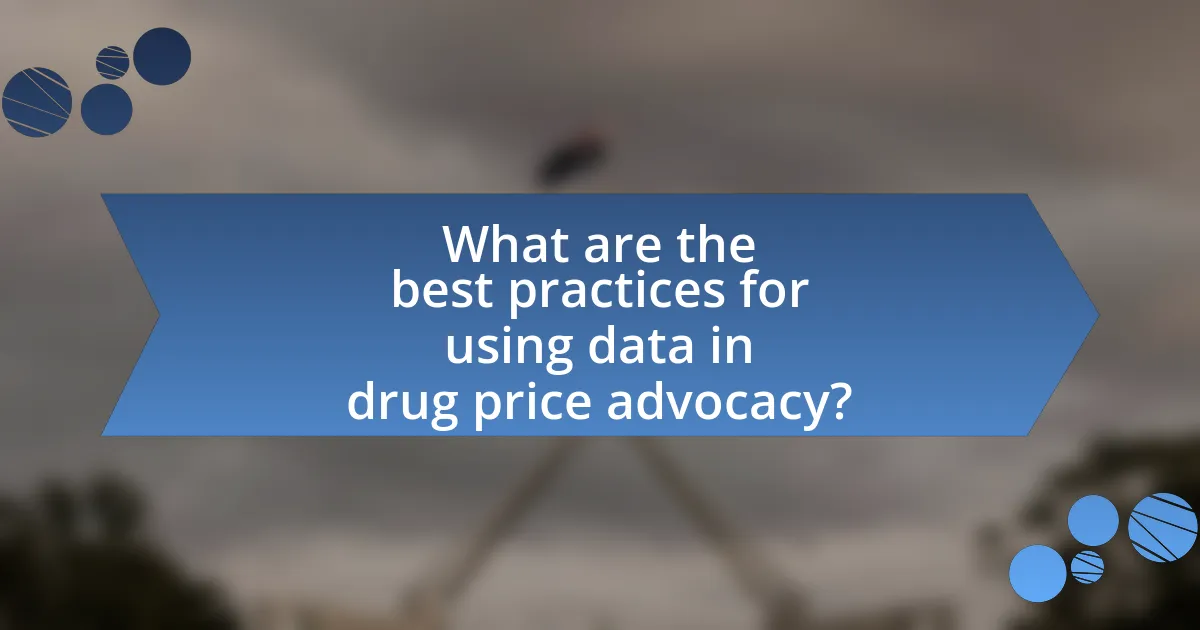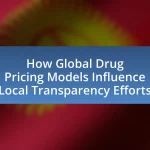The article focuses on the critical role of data in advocating for lower drug prices, emphasizing how evidence-based insights can highlight pricing disparities and their impact on public health. It discusses various methods for identifying high drug prices, the types of data that effectively reveal price disparities, and the importance of patient testimonials in complementing data-driven advocacy. Additionally, the article outlines strategies for analyzing drug pricing data, the significance of comparative analysis, and best practices for ensuring data accuracy and effective communication. By leveraging comprehensive data sources and employing clear visualizations, advocates can strengthen their efforts to push for policy changes aimed at reducing drug costs and improving healthcare access.

What is the role of data in advocating for lower drug prices?
Data plays a crucial role in advocating for lower drug prices by providing evidence-based insights that highlight pricing disparities and the impact of high costs on public health. For instance, analyses of drug pricing data can reveal how prices vary across different regions and countries, demonstrating potential savings if prices were aligned with those in lower-cost markets. Additionally, data on patient outcomes and healthcare expenditures can illustrate the financial burden of high drug prices on individuals and the healthcare system, reinforcing the need for policy changes. Studies, such as those conducted by the Institute for Clinical and Economic Review, have shown that transparent pricing data can lead to more informed negotiations between payers and manufacturers, ultimately driving prices down.
How can data be used to identify high drug prices?
Data can be used to identify high drug prices by analyzing pricing information across various markets and comparing it to benchmarks such as average costs, historical prices, and prices in other countries. For instance, the Institute for Clinical and Economic Review (ICER) provides reports that compare drug prices against their clinical benefits, revealing discrepancies that indicate high pricing. Additionally, databases like the Medicare Part D drug pricing data allow researchers to track price variations and identify outliers that exceed typical pricing thresholds. This data-driven approach enables stakeholders to pinpoint drugs that are priced significantly higher than their therapeutic value or market norms, facilitating advocacy for price reductions.
What types of data are most effective in highlighting price disparities?
Quantitative data, such as pricing data from various pharmacies, insurance claims data, and market research reports, are most effective in highlighting price disparities. This type of data allows for direct comparisons of drug prices across different locations and providers, revealing significant variations. For instance, a study by the Health Care Cost Institute found that the price of a common medication can vary by over 300% depending on the pharmacy, illustrating the extent of price disparities. Additionally, data on patient demographics and socioeconomic factors can provide context to these disparities, showing how they disproportionately affect certain populations.
How do patient testimonials complement data in advocacy?
Patient testimonials complement data in advocacy by providing personal narratives that humanize statistical information, making it more relatable and impactful. While data offers quantitative evidence of issues such as high drug prices, testimonials illustrate the real-life consequences of these issues, thereby fostering emotional connections with policymakers and the public. For instance, a study published in the Journal of Health Economics found that personal stories can significantly influence public opinion and legislative decisions, demonstrating that emotional appeals can enhance the effectiveness of data-driven advocacy efforts.
Why is it important to advocate for lower drug prices using data?
Advocating for lower drug prices using data is crucial because it provides evidence-based support for policy changes that can enhance affordability and accessibility. Data-driven advocacy allows stakeholders to identify pricing trends, compare costs across different regions, and highlight disparities in drug pricing, which can lead to informed decision-making. For instance, a study by the House of Representatives Ways and Means Committee in 2019 revealed that Americans pay, on average, four times more for prescription drugs than citizens in other developed countries. This concrete evidence underscores the need for reform and empowers advocates to push for legislative changes that can lower costs for consumers.
What impact does high drug pricing have on public health?
High drug pricing negatively impacts public health by limiting access to essential medications for patients. When prices are elevated, individuals may forgo necessary treatments, leading to worsened health outcomes, increased hospitalizations, and higher overall healthcare costs. For instance, a study published in the Journal of the American Medical Association found that nearly 25% of Americans reported not filling a prescription due to cost, which can exacerbate chronic conditions and lead to preventable complications. This situation creates a cycle where high drug prices contribute to poorer health, ultimately straining public health systems and increasing the burden on healthcare resources.
How can data-driven advocacy influence policy changes?
Data-driven advocacy can influence policy changes by providing empirical evidence that supports specific policy recommendations. For instance, organizations can analyze healthcare data to demonstrate the financial burden of high drug prices on consumers, which can lead to legislative proposals aimed at price regulation. A study by the House of Representatives Ways and Means Committee in 2019 found that nearly one in four Americans reported not filling a prescription due to cost, highlighting the urgent need for policy intervention. By presenting such data, advocates can effectively persuade policymakers to prioritize reforms that address drug pricing issues.
What are the key data sources for drug price advocacy?
Key data sources for drug price advocacy include government databases, pharmaceutical pricing reports, and health insurance claims data. Government databases, such as the Centers for Medicare & Medicaid Services (CMS) and the Food and Drug Administration (FDA), provide essential information on drug pricing and utilization. Pharmaceutical pricing reports from organizations like the Institute for Clinical and Economic Review (ICER) offer insights into cost-effectiveness and pricing trends. Health insurance claims data, which can be accessed through private insurers or public health programs, reveal actual expenditures on medications, helping to highlight disparities in drug pricing. These sources collectively support advocacy efforts by providing concrete evidence of pricing issues and trends in the pharmaceutical market.
Which government databases provide relevant pricing information?
The government databases that provide relevant pricing information include the Centers for Medicare & Medicaid Services (CMS) database, the National Drug Code Directory, and the Drug Enforcement Administration (DEA) database. The CMS database offers pricing data for drugs covered under Medicare and Medicaid, which is crucial for understanding drug costs in these programs. The National Drug Code Directory contains information on drug products, including pricing, which aids in identifying market prices. The DEA database tracks controlled substances and their pricing, providing insights into pricing trends for regulated medications. These databases collectively serve as essential resources for analyzing and advocating for lower drug prices.
How can non-profit organizations contribute data for advocacy?
Non-profit organizations can contribute data for advocacy by collecting and analyzing relevant information on drug pricing, patient access, and health outcomes. These organizations often gather data through surveys, research studies, and collaborations with healthcare providers, which can highlight disparities in drug affordability and access. For instance, a report from the Kaiser Family Foundation found that nearly one in four Americans reported not filling a prescription due to cost, illustrating the urgent need for advocacy based on concrete data. By presenting this data to policymakers, non-profits can effectively advocate for policy changes aimed at lowering drug prices and improving healthcare access.
How can advocates effectively communicate data to stakeholders?
Advocates can effectively communicate data to stakeholders by utilizing clear visuals, concise summaries, and relatable narratives. Clear visuals, such as graphs and charts, help stakeholders quickly grasp complex information, while concise summaries distill key points, making the data more accessible. Relatable narratives contextualize the data, allowing stakeholders to understand its real-world implications. For instance, a study by the Kaiser Family Foundation found that visual data representation increases retention and understanding by up to 80%, demonstrating the effectiveness of these methods in conveying important information about drug pricing.
What strategies can enhance the impact of data in advocacy efforts?
Utilizing clear visualization techniques enhances the impact of data in advocacy efforts. Effective data visualization, such as charts and infographics, allows stakeholders to quickly grasp complex information, making it more accessible and persuasive. For instance, a study by the Data Visualization Society found that visualized data can increase retention rates by up to 65%, compared to text alone. Additionally, tailoring data narratives to specific audiences ensures that the information resonates, as evidenced by research from the Pew Research Center, which indicates that targeted messaging significantly improves engagement and response rates in advocacy campaigns.

What methods can be employed to analyze drug pricing data?
Methods to analyze drug pricing data include statistical analysis, comparative pricing studies, and econometric modeling. Statistical analysis involves using descriptive statistics to summarize pricing trends and variations across different markets. Comparative pricing studies assess drug prices against benchmarks, such as prices in other countries or prices for similar drugs, to identify discrepancies. Econometric modeling applies statistical methods to understand the relationship between drug prices and various factors, such as market competition and regulatory policies. These methods provide insights that can inform advocacy efforts for lower drug prices by highlighting unjustified price increases and disparities in access.
How can statistical analysis reveal trends in drug pricing?
Statistical analysis can reveal trends in drug pricing by examining historical price data, identifying patterns, and correlating factors that influence price changes. For instance, analyzing data from sources like the Centers for Medicare & Medicaid Services (CMS) can show how prices for specific medications have increased over time, often correlating with market exclusivity or patent expirations. Additionally, statistical methods such as regression analysis can quantify the impact of external factors, such as regulatory changes or market competition, on drug prices. This data-driven approach enables stakeholders to understand pricing dynamics and advocate for policy changes aimed at reducing costs.
What tools are available for analyzing drug price data?
Tools available for analyzing drug price data include software platforms like IBM Watson Health, which utilizes advanced analytics to assess drug pricing trends, and GoodRx, which provides pricing information and comparisons across pharmacies. Additionally, the Centers for Medicare & Medicaid Services (CMS) offers databases such as the Medicare Part D Drug Spending Dashboard, allowing users to analyze spending patterns. These tools enable stakeholders to identify pricing discrepancies and advocate for lower drug prices effectively.
How can visualizations enhance understanding of drug pricing issues?
Visualizations enhance understanding of drug pricing issues by presenting complex data in an accessible and interpretable format. They allow stakeholders, including policymakers and the public, to quickly grasp trends, disparities, and the impact of pricing on different populations. For instance, a study by the Kaiser Family Foundation found that visual data representations, such as graphs and charts, can effectively illustrate the rising costs of medications over time, making it easier to identify patterns and correlations. This clarity can drive informed discussions and decisions regarding drug pricing reforms.
What role does comparative analysis play in advocacy?
Comparative analysis plays a crucial role in advocacy by enabling advocates to evaluate and contrast different policies, practices, or outcomes related to drug pricing. This analytical approach allows advocates to identify effective strategies and highlight disparities in drug costs across various regions or countries. For instance, a study by the House of Representatives in 2020 revealed that the U.S. pays significantly higher prices for prescription drugs compared to other developed nations, which can be leveraged in advocacy efforts to push for policy reforms aimed at lowering drug prices. By utilizing comparative analysis, advocates can present compelling evidence that supports their arguments, making it easier to persuade policymakers and the public about the need for change.
How can comparing drug prices across countries strengthen arguments?
Comparing drug prices across countries strengthens arguments by providing concrete evidence of price disparities that can highlight the need for policy changes. For instance, a study by the House of Representatives Ways and Means Committee in 2019 revealed that Americans pay, on average, four times more for prescription drugs than consumers in other developed countries. This data can be used to advocate for reforms in pricing strategies and to push for legislation aimed at reducing drug costs. By presenting such comparisons, advocates can effectively illustrate the inequities in healthcare access and affordability, thereby reinforcing their case for lower drug prices.
What are the limitations of comparative analysis in this context?
Comparative analysis in the context of advocating for lower drug prices has several limitations, primarily due to the variability in drug pricing, market dynamics, and regulatory environments. These limitations include the challenge of accounting for differences in drug formulations, patient populations, and healthcare systems across regions, which can skew comparisons. Additionally, comparative analysis may not adequately capture the complexities of value-based pricing models, where the effectiveness of a drug is weighed against its cost, leading to potential misinterpretations of data. Furthermore, the reliance on available data can introduce biases, as not all drug pricing information is transparent or accessible, limiting the comprehensiveness of the analysis.
How can case studies be used to support advocacy efforts?
Case studies can be used to support advocacy efforts by providing concrete examples that illustrate the impact of high drug prices on individuals and communities. These detailed narratives highlight personal experiences and outcomes, making the issue more relatable and urgent for policymakers and the public. For instance, a case study detailing a patient’s struggle to afford necessary medication can evoke empathy and drive home the need for policy changes. Research shows that storytelling through case studies can increase engagement and support for advocacy initiatives, as evidenced by a study published in the Journal of Health Communication, which found that personal stories significantly influenced public opinion on healthcare policies.
What are some successful examples of data-driven advocacy?
Successful examples of data-driven advocacy include the campaign by the advocacy group Patients for Affordable Drugs, which utilized data on drug pricing to highlight the disparity between the costs of medications in the U.S. and other countries. This campaign effectively mobilized public support and influenced legislative discussions on drug pricing reform. Another example is the work of the Institute for Clinical and Economic Review (ICER), which analyzes drug pricing data and provides reports that inform policymakers and stakeholders about the value of medications, leading to more informed decisions regarding pricing and access. These initiatives demonstrate how leveraging data can drive impactful advocacy efforts in the healthcare sector.
How can case studies be effectively presented to stakeholders?
Case studies can be effectively presented to stakeholders by utilizing a clear structure that highlights key findings, relevant data, and actionable insights. This approach ensures that stakeholders can easily grasp the implications of the case study. For instance, presenting a case study on lower drug prices should include a concise summary of the issue, data supporting the need for change, and specific examples of successful interventions. Research indicates that visual aids, such as graphs and charts, enhance understanding and retention of information, making the presentation more impactful. Additionally, tailoring the presentation to the stakeholders’ interests and concerns increases engagement and facilitates informed decision-making.

What are the best practices for using data in drug price advocacy?
The best practices for using data in drug price advocacy include ensuring data accuracy, utilizing comprehensive datasets, and effectively communicating findings. Accurate data is essential as it builds credibility; for instance, using verified pricing information from sources like the Centers for Medicare & Medicaid Services enhances trust. Comprehensive datasets, such as those from the National Institute for Health Care Management, provide a broader context for understanding price trends and disparities. Effective communication involves translating complex data into accessible formats, such as infographics or clear reports, to engage stakeholders and policymakers. These practices collectively strengthen advocacy efforts by making a compelling case for lower drug prices based on solid evidence.
How can advocates ensure data accuracy and reliability?
Advocates can ensure data accuracy and reliability by employing rigorous data validation techniques and utilizing credible sources. This involves cross-referencing data from multiple reputable organizations, such as the World Health Organization and the Centers for Disease Control and Prevention, to confirm the consistency and credibility of the information. Additionally, advocates should apply statistical methods to assess data quality, including checking for outliers and ensuring that sample sizes are adequate to support conclusions. By adhering to these practices, advocates can substantiate their claims with reliable data, thereby enhancing the effectiveness of their advocacy for lower drug prices.
What steps should be taken to verify data sources?
To verify data sources, one should assess the credibility, accuracy, and relevance of the information. First, check the author’s qualifications and affiliations to ensure they have expertise in the subject matter. Next, evaluate the publication date to confirm the data is current and applicable. Additionally, cross-reference the data with other reputable sources to validate its accuracy. Finally, consider the methodology used to gather the data, as transparent and rigorous methods enhance reliability. For instance, studies published in peer-reviewed journals typically undergo scrutiny, making them more trustworthy.
How can advocates stay updated on new data and trends?
Advocates can stay updated on new data and trends by regularly engaging with reputable sources of information, such as academic journals, industry reports, and government publications. For instance, subscribing to newsletters from organizations like the National Institute for Health Care Management or the Kaiser Family Foundation provides timely insights into healthcare trends and drug pricing data. Additionally, attending conferences and webinars focused on healthcare policy and pharmaceutical economics allows advocates to network with experts and gain firsthand knowledge of emerging issues. Research indicates that continuous education and information sharing are critical for effective advocacy, as staying informed enables advocates to make data-driven arguments for lower drug prices.
What are common pitfalls to avoid in data-driven advocacy?
Common pitfalls to avoid in data-driven advocacy include misinterpreting data, failing to contextualize findings, and neglecting the target audience’s needs. Misinterpreting data can lead to incorrect conclusions, which undermines credibility; for instance, using correlation to imply causation without proper analysis can mislead stakeholders. Failing to contextualize findings means presenting data without explaining its relevance, which can confuse or alienate the audience. Neglecting the target audience’s needs results in advocacy efforts that do not resonate, as effective communication requires tailoring messages to the specific concerns and values of the audience. These pitfalls can significantly diminish the effectiveness of advocacy efforts aimed at lowering drug prices.
How can misinterpretation of data undermine advocacy efforts?
Misinterpretation of data can significantly undermine advocacy efforts by leading to incorrect conclusions that misguide policy decisions. For instance, if advocates present inflated statistics about drug prices without context, it may create a false narrative that oversimplifies complex issues, resulting in ineffective or harmful policy responses. A study by the National Bureau of Economic Research found that misleading data interpretations can lead to public mistrust and disengagement, ultimately weakening the advocacy’s credibility and impact. Accurate data representation is essential for fostering informed discussions and achieving meaningful change in drug pricing policies.
What strategies can prevent data overload in presentations?
To prevent data overload in presentations, focus on simplifying information through clear visuals and concise messaging. Utilizing charts, graphs, and infographics can effectively convey complex data in an easily digestible format, allowing the audience to grasp key points quickly. Research indicates that visuals can enhance retention by up to 65% compared to text alone. Additionally, limiting the number of data points per slide to three to five key insights helps maintain audience engagement and comprehension. This approach aligns with cognitive load theory, which suggests that reducing extraneous information allows for better processing of essential content.
What practical tips can enhance the effectiveness of data advocacy?
To enhance the effectiveness of data advocacy, it is crucial to present clear, compelling narratives that connect data to real-world impacts. This approach engages stakeholders by illustrating how data-driven insights directly affect individuals and communities, particularly in the context of lower drug prices. For instance, using case studies that highlight the financial burden of high drug costs can make the data more relatable and urgent. Additionally, employing visual aids such as graphs and infographics can simplify complex data, making it more accessible and persuasive. Research shows that visual information is processed 60,000 times faster than text, which underscores the importance of effective data presentation in advocacy efforts.


